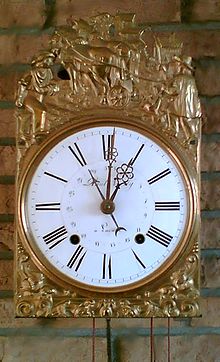Comtoise clock
A Comtoise clock (short: Comtoise , also called Burgundy clock and Morbier clock ) is a French pendulum clock from the French region Franche-Comté . It was made near Morez from around 1680 until the end of the 19th century . It was hardly known outside of France until around 1950. It is now a popular collector's item among antique lovers . Their very loud chime is typical.
history
The Comtoise was originally intended for simple households that only owned a watch. Their loud bang could be heard throughout the house.
18th century
For reasons of better transportability, the pendulum of these clocks consisted of a lead pear that hung on a wire chain made up of numerous links. The weights, which due to the construction of the movement i. d. Usually each weighed around five kilograms, for this reason alone could not be transported, but were individually manufactured by the local blacksmith. The appearance of Comtoisen this period was characterized by the typical black, almost cubical looking case and the domed enamel dial with bronze - applications . A bronze appliqué, mostly in the form of the Gallic rooster, served as a top or crown, which is why these clocks are also called "chicken clocks" in specialist circles. On the right and left were sheet metal doors that allowed an insight into the work.
The work usually consisted of four pillars into which the large brass wheels were inserted by drives. The spindle escapement served as an escapement . The weight drive for the gear and striking mechanism was operated with ropes. The chicken clock already had a repeating mechanism, ie the hour that had struck was repeated again after two minutes. This was particularly useful at night when you were woken up by the chiming of the clock but had not noticed the number of chimes.
19th century
The clocks of the 19th century initially differed only slightly from their predecessors. Instead of the bronze applications, embossed brass plates with some beautiful motifs now surrounded the dial, which was still made of enamel. The movement had been transformed into a front swing, that is, in the current clocks the pendulum swung in front of instead of behind the weights. The spindle escapement, however, remained. Also new was the folding pendulum, which consisted of a foldable metal rod due to the transport problems already described. The lead bulb had given way to a decorative pendulum lens made of brass. In addition to the blacksmith, the local carpenter had also dealt with the Comtoise. The manufacture of decorative wooden cases, which the Comtoise now supplemented from the classic wall or chair clock with a grandfather clock , was one of his tasks from then on. Due to the wide swing of the pendulum, the wooden housing of a Comtoise was shaped by a bulbous shape. In the late period of these clocks, the cases were mostly made of softwood with a decorative painting.
Other changes in the 19th century included the introduction of the lyre pendulum and the embossed brass pendulum. The latter was provided in various designs with an automaton , in which mostly a craft scene was represented, the figures of which moved to the rhythm of the pendulum. The use of the much heavier lyre and brass pendulums made the anchor escapement necessary from then on , since the spindle escapement could no longer provide the necessary force for propulsion for the higher weight of the pendulum.
After the Second World War, the Comtoise clocks became popular as antiques , especially in the 1970s, many examples made their way to Germany through trade. Particularly early specimens or those with special functions (quarter-hour strike, date display, machines, etc.) are still sought-after collector's items today. Since this type of watch was traded for a long time at very high prices, pieces that have been heavily supplemented or newly assembled from individual parts of different origins are also in circulation ( Mariage ).
literature
- Siegfried Bergmann: Comtoise-Uhren - History - Technology - Typology , La Pendule Stolberg, 2012.
- Gustav Schmitt: Die Comtoise-Uhr , Verlag Müller Villingen 1983, ISBN 3-920662-05-9 .
- Siegfried Bergmann: Comtoise-Uhren , La Pendule Stolberg, 2005.
- Bernd Deckert: The history of Comtoise watches , 2 volumes, Comtoise watch museum, Düsseldorf 2008.
- Ton Bollen: Comtoiseklokken , Unieboek bv, Bussum 1976, ISBN 90-228-4253-3
- Bernd Deckert: Origin of the Comtoise watches. Comtoise Clock Museum, Düsseldorf 2018.
Individual evidence
- ↑ Viktor Pröstler: Callwey's handbook of clock types [...] . Callwey, Munich 1994, ISBN 3-7667-1098-2 .
